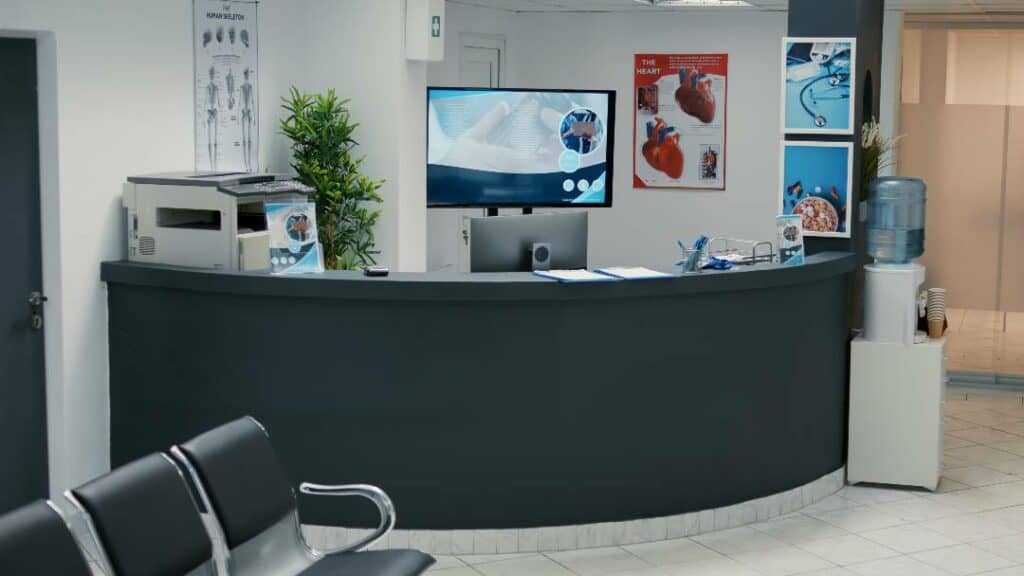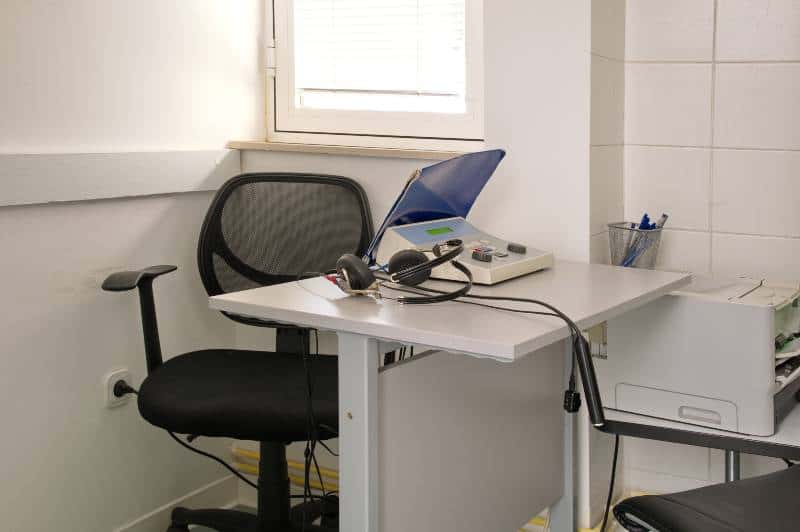As a business owner, it is important to have an understanding of the different types of medical properties available and how best to manage to lease them. Knowing what kind of property is right for your practice or clinic, as well as how to maintain the health and safety standards associated with running a medical business can save you time and money in the long run.
This guide will provide insight into areas such as leased space considerations, finding the ideal lease agreement terms, establishing industry-standard protocols within healthcare facilities, and several tips related to leasing medical spaces in addition to other critical topics that are essential when helping you find solutions that work best for you. Start taking control by learning more today!
Maddie Holmes, a Senior Healthcare Analyst at JLL in New York, reported that medical office absorption reached a record high in 2021, with 18.5 million sq. ft. on a trailing fourth-quarter basis—almost double the typical rate observed since 2019. This robust demand persisted in 2022 and 2023, despite the growing prominence of telemedicine in healthcare.
Key Takeaways
- The real estate industry is a complicated one, but managing and leasing medical commercial spaces doesn’t have to be.
- To make sure you’re successful in this endeavor, it’s essential for your profits forecast to stay grounded in reality and establish tenant agreements with confidence.
- Knowledge of the relevant laws and regulations is also a key part of running things smoothly.

Understanding Medical Commercial Space Requirements
Types of medical facilities
When it comes to medical facilities, there are a variety of spaces that can accommodate different levels of care. Some facilities are designed for general practitioners and other primary care providers, while others cater to specialists like surgeons or dermatologists. Medical commercial spaces can come in many different forms, from small private practices in office buildings to major hospitals with multiple floors and wings. These facilities often require specific features to support their unique needs, such as specialized equipment, ample storage space, and dedicated staff areas.
Understanding the requirements for medical commercial space can be crucial for healthcare providers looking to design or rent a facility that suits their needs. Some common types of medical facilities include:
Hospitals: With the increasing demand for healthcare services, hospitals are becoming larger and more complex. They are not just places for medical treatment but also centers for innovation, research, and education. To accommodate all the different departments and specialized amenities required for modern healthcare, hospitals need a lot of space. From operating rooms and intensive care units to laboratories and administrative offices, every aspect of a hospital demands a specific type of space
Clinics: Smaller facilities that offer outpatient care, such as general practice, dental, or specialized clinics (e.g., dermatology, pediatrics). Clinics may need less space than hospitals but require separate rooms for consultations, examinations, and minor procedures.
Diagnostic Centers: Diagnostic facilities specialize in services such as imaging (MRI, CT scans, X-rays) and laboratory tests. They require designated space for equipment, waiting for areas, and administrative functions.
Ambulatory Surgery Centers: These are medical centers where surgical procedures are done on an outpatient basis. They have specific areas for pre-operative care, and post-operative care, as well as operating rooms and sterilization areas.
Rehabilitation Centers: Rehabilitation centers that specialize in physical therapy, occupational therapy, and other similar services require sufficient room for treatment areas, exercise machines, and therapy rooms.
Zoning and regulatory considerations
Each city or jurisdiction has specific zoning regulations and building codes that dictate the types of businesses and facilities allowed in a given area. To ensure compliance, consider the following:
Zoning Restrictions: Medical facilities are subject to zoning restrictions in most communities. Zoning regulations may address parking, traffic impact, and size of the structure among other issues. As a consequence, a medical facility developer will likely need to obtain a conditional use permit from the local zoning board or commissioners before proceeding with the construction of any site plans.
Building Codes: When it comes to understanding medical commercial space requirements, zoning, and regulatory considerations should be at the forefront of any facility planning. One key consideration is adherence to local building codes, which demand compliance with safety protocols for electrical systems, plumbing, HVAC, and fire safety. Medical facilities have unique requirements for infection control, radiation protection, and hazardous materials handling, which must be strictly followed in order to ensure safety and compliance
Licensing and Certification: When it comes to understanding medical commercial space requirements, one of the key considerations is zoning and regulatory requirements. This is an important factor to consider because different jurisdictions often have different regulations and requirements for medical facilities. In addition, licensing and certification are also critical considerations to make. It’s important to ensure that the facility is up to the standards set by relevant licensing bodies and accrediting organizations, such as the department of health or national accrediting organizations.
Americans with Disabilities Act (ADA) Compliance: As you consider the requirements for medical commercial space, it’s important to take into account the zoning and regulatory considerations that come along with it. Specifically, one important area to consider is compliance with the Americans with Disabilities Act (ADA). Ensuring that your facility is accessible to all individuals, regardless of their physical abilities, is not only a legal requirement but it’s also just good business. This means following ADA guidelines for entrances, exits, restrooms, and other public spaces.
By prioritizing accessibility in your medical commercial space, you’ll create a more inclusive environment for your patients and staff, which can ultimately benefit your business in the long run.
Accessibility and parking requirements
As the healthcare industry continues to grow, so does the demand for medical commercial space. To ensure that this space meets the needs of both medical professionals and patients, it’s important to consider accessibility and parking requirements. Adequate parking is essential for patients who may have mobility issues or require a wheelchair, as well as for medical professionals who need quick access to their workspace.
In addition, ensuring that the space is compliant with accessibility laws is crucial for providing equal access to all patients. These considerations ensure that medical commercial space meets the needs of those who rely on it most and helps to create a welcoming and functional environment for all.
Marketing Medical Commercial Space
Target audience
To effectively market a medical commercial space, it is crucial to identify the target audience and customize the marketing strategy for them. The target audience for a medical commercial space usually comprises healthcare professionals, facility administrators, investors, and healthcare organizations. Here are some suggestions for promoting medical commercial spaces to the right audience:
Understand the needs of your target audience:
A. Healthcare Professionals: When it comes to marketing medical commercial space, understanding the needs of your target audience is crucial. In the case of healthcare professionals, their specific requirements should be taken into consideration. Doctors, dentists, and therapists all have distinct space needs, which can include factors such as the size of their offices, the types of equipment they require, and the layout and availability of waiting areas and exam rooms.
By understanding these unique requirements and tailoring your marketing efforts to them, you can attract the right healthcare professionals to your commercial space and ensure they have all the necessary tools and amenities to provide exceptional care to their patients.
B. Facility Administrators: When it comes to marketing medical commercial space, it’s important to understand the needs and preferences of your target audience. If you are targeting facility administrators, their main concern is the practicality of the space design. They want a space that adheres to regulations, is energy-efficient, easy to maintain, and has a functional layout. To appeal to this audience, focus on highlighting these practical aspects of your space. Emphasize how your space is designed to meet their needs and how it will help them run their facility smoothly and efficiently.
C. Investors: To effectively communicate the value of your property, you need to showcase its potential for growth in the healthcare sector. This means presenting market trends, data on the demand for medical services in the area, and the property’s potential for long-term appreciation. With this information, you can effectively highlight the return on investment and create a compelling case for why investors should invest in your space
D. Healthcare Organizations: Larger healthcare organizations like hospitals or health systems have specific requirements for their commercial space, which must be met to consider moving forward. For example, they need space that allows for future expansion or opening of satellite facilities. As a marketer, you’ll want to showcase how your commercial space can accommodate these needs, making it an attractive option for healthcare organizations looking to grow and expand their footprint in the market
Develop targeted marketing materials
Marketing medical commercial space can be a daunting task, but tailoring your materials to each specific segment of your target audience can make all the difference. For your healthcare professional audience, emphasizing the layout, amenities, and functionality of the space will show them that it’s designed with their needs in mind. On the other hand, investors will be more interested in seeing the financial side of things, such as growth potential and return on investment.
Showcase the location and accessibility:
When it comes to marketing your medical commercial space, showcasing its location and accessibility is crucial. Patients want to be able to easily access your office, so highlighting its proximity to public transportation, major highways, and residential areas is key. Not only that, but it’s important to emphasize the available parking and accessibility features as well.
Highlight zoning and regulatory compliance
As the world of healthcare continues to evolve, it’s vital to have the right commercial medical space to meet the unique needs of medical professionals. When marketing medical commercial space, it’s essential to highlight zoning and regulatory compliance, ensuring that the property meets all local regulations and building codes. Emphasizing any certifications or accreditations, the facility has earned can certainly make it stand out, helping potential tenants and investors to trust that the space meets the necessary legal and safety requirements.
Collaborate with a commercial real estate agent
When it comes to understanding medical commercial space requirements, partnering with a commercial real estate agent can make all the difference. With their expertise in the field of medical properties, they can help you identify potential tenants and navigate the leasing process, making the entire experience much smoother. Additionally, by leveraging market trends and understanding what tenants look for in their space, they can help position your property in a way that maximizes its value.
Online and offline marketing strategies
To successfully promote their brand, businesses need to combine both online and offline marketing strategies. Digital marketing allows companies to reach a wider audience through social media, email campaigns, and search engine optimization, while traditional marketing methods such as direct mail or print ads can help establish a physical presence and make a lasting impression on potential customers. The key is to find the right balance between the two and use a variety of tactics to create a consistent message that resonates with your target audience
Collaboration with medical industry organizations
The medical field is constantly evolving, and it’s crucial for medical offices to keep up with the latest developments in order to provide top-notch care for their patients. One way to do this is by collaborating with medical industry organizations, which can offer valuable insights and resources to help improve medical office spaces, buildings, operations, and patient care.
Partnering with these organizations can offer medical offices access to training, educational resources for staff, cutting-edge technology and medical devices, and opportunities for physician practices to participate in research studies and clinical trials. This helps them provide top-notch care to patients and stay up-to-date.
Ready to take the next step in launching your medical office? Before you sign on the dotted line, make sure to check out our helpful guide that outlines all of the pros and cons associated with leasing space. With this knowledge under your belt, I’d be happy to help get everything leased up – so we can jumpstart achieving success for your business.
Tenant Screening and Selection
Criteria for ideal medical tenants
When looking for ideal medical tenants for your commercial space, there are several criteria to consider. These criteria can help ensure that you select tenants who will be reliable, contribute positively to the property, and have a stable and successful practice. Some criteria for ideal medical tenants include:
Reputation and Experience
When it comes to leasing commercial space for medical practices, there are certain criteria that landlords typically look for in their tenants. One of these is a strong reputation and ample experience in the field. Medical practitioners who have established their presence in the industry are often viewed as more reliable and trustworthy, which can boost the confidence of both patients and landlords. Additionally, experienced medical professionals tend to have a better understanding of their space requirements and are less likely to encounter logistical issues down the line.
Financial Stability
In today’s fast-paced world, the healthcare industry is booming, and with it, the demand for medical commercial space. However, not all tenants are ideal for medical properties. One of the key criteria for perfect medical tenants is sound financial stability. Since medical properties are expensive to maintain and require significant capital, having a financially stable tenant ensures that the property remains in good condition, and upkeep and can provide quality care. Medical tenants who can pay rent promptly and have solid financial statements increase the likelihood of long-term leases, which can be beneficial for property owners.
Compatibility with Existing Tenants
While it may be tempting to fill rental space quickly, it is essential to ensure new medical tenants do not clash with current occupants. For instance, a dentist’s office may be a perfect fit for a building that houses a general practitioner, but it might not be the right fit for a building that houses a pharmacy. By identifying the best match for property objectives, a landlord can cultivate a harmonious and profitable tenant mix.
Compliance with Rules and Regulations
It’s crucial to make sure that any potential tenants are fully licensed and qualified to operate their business, and that their operations will fully comply with any zoning restrictions, building codes, and other regulations. This not only protects the tenant but also ensures the safety and well-being of their patients and the surrounding community.
Commitment to Patient Care
When it comes to finding the perfect medical tenant, commitment to patient care should be at the top of your list of criteria. The best medical tenants are those who prioritize their patients and are dedicated to providing top-notch care. This means not only being knowledgeable and skilled in their field but also having a genuine concern for the well-being of their patients. Tenants who are committed to patient care are more likely to have a positive reputation in the community, attract loyal patients, and enjoy long-term success.
Adaptability and Flexibility
Medical facilities often require customized layouts and unique infrastructure for specialty equipment, making it crucial for tenants to be willing to work with the landlord to create a space that suits their needs. This level of flexibility also extends to regulations and compliance issues, as medical practices must adhere to strict safety and waste disposal standards.
Long-Term Growth Potential
While any tenant can provide short-term value for landlords, it’s important to look beyond the immediate future and consider how a tenant’s growth may impact the space over time. A medical tenant with long-term growth potential may require more square footage as their practice expands or may attract more patients as their reputation grows. It’s important to consider these factors when choosing a tenant to ensure that the space meets their needs not only now but also in the years to come.
Professionalism and Communication
You want a tenant who will treat your property with respect and maintain a high standard of professionalism in their interactions with patients and other tenants. Additionally, good communication skills are crucial in ensuring that any issues or concerns can be addressed in a timely and effective manner.
By considering these criteria, you can identify ideal medical tenants who will contribute to the success of your commercial space and maintain a stable, successful practice.
Financial and background checks
When screening potential medical tenants for your commercial space, it is essential to conduct financial and background checks to ensure they are reliable and can fulfill their lease obligations. Here are some key steps to take when conducting financial and background checks:
Credit Check
When leasing commercial space for medical purposes, it’s critical to ensure potential tenants are financially and professionally sound. Conducting credit and background checks can help identify any red flags that could pose risks down the line. While a perfect credit score may not be necessary, a thorough evaluation of a tenant’s creditworthiness can give you the insight you need to protect your investment. The background check should also include any licensure or certification requirements specific to the medical industry to ensure the tenant is qualified to practice in your building.
Income Verification
When looking for commercial space for a medical business, understanding the space requirements is only half the battle. Landlords and property managers will also want to thoroughly vet potential tenants before agreeing to a lease agreement. This includes conducting financial and background checks to ensure that the tenant has the means to pay rent and a track record of responsible behavior.
Income verification is also common to verify that the tenant’s income meets the minimum requirements set by the landlord. These measures may seem stringent, but they are in place to protect both the landlord and the tenant and ensure a successful business arrangement.
Rental History
One of the most crucial elements to keep in mind is ensuring that potential tenants will be financially responsible and trustworthy. When evaluating potential tenants, it’s crucial to conduct a thorough background check to ensure that they have a solid financial history and won’t put your investment at risk. Additionally, checking their rental history can give you a better understanding of their ability to maintain a long-term lease commitment.
Professional Background Check
Perform a thorough background check on the physician tenant, to verify their qualifications, licenses, and work history. You can contact state medical boards, professional associations, or other relevant organizations to verify their credentials and check for any disciplinary actions or malpractice claims against them.
Criminal Background Check
Perform a criminal background check to identify any criminal history that may pose a risk to the property or other future tenants. While minor offenses may not necessarily disqualify a potential tenant, serious crimes or patterns of criminal behavior should be carefully considered.
Lease negotiation process
To negotiate a lease for a medical commercial space, there are multiple steps that both the landlord and tenant must take to come to a mutually beneficial agreement. These steps typically include:
Research and Preparation
To prepare for lease negotiations, the landlord and tenant should research market conditions, similar properties, and the medical practice’s specific requirements. This assists in establishing practical expectations and comprehending what is reasonable and attainable during negotiations.
Term Sheet or Letter of Intent (LOI)
To begin the lease agreement negotiation process, both the tenant and the landlord should create a term sheet or a letter of intent. This document should clearly outline important details such as rent, lease length, space improvements, maintenance responsibilities, and other essential terms.
Legal Representation
It is advisable for both parties to hire an attorney who is experienced in dealing with both commercial leases and lease negotiations. An attorney can assist in scrutinizing the lease terms, offering advice on possible legal problems, and ensuring that the final lease agreement adheres to local laws and regulations while remaining legally valid.
Negotiating Key Terms
To come to an agreement on the lease agreement, the landlord and tenant should have conversations and negotiations. It’s important to negotiate on key terms such as:
A. Rent: Calculate the initial rental amount and any potential increases for the duration of the lease. Take into account factors such as the current rental market, property location and condition, and the financial stability of the tenant.
B. Lease Duration: Make sure to come to an agreement regarding the duration of the lease, including the length of its initial term, as well as any options for renewal or early termination.
C. Tenant Improvements: You need to discuss necessary improvements or expansions required to support the medical practice. Additionally, we must negotiate and determine who will be responsible for overseeing and covering the costs of these projects.
D. Maintenance and Repairs: Clarify the responsibilities for maintenance and repairs of common areas, building systems, and individual tenant spaces for each party involved.
E. Security Deposit: Come to a mutual agreement regarding the specified amount and requirements for the security deposit, including the terms and conditions for both refund and forfeiture.
F. Insurance and Liability Please clarify the insurance requirements for both parties and provide guidelines for how to proceed with property damage, personal injury claims, or any other liabilities.
Review and Revision of Lease Agreement
After agreeing on the important terms, both parties should create and review the lease agreement with the help of their legal representatives. This step may require several revisions and discussions to make sure that all terms are well-defined and acceptable to both parties.
Execution of Lease Agreement
Once the final lease terms are agreed upon by both parties and legal counsel has reviewed the lease agreement, the landlord and tenant should sign the full lease document. The signing should follow the local laws, and each party ought to keep a copy of the signed lease for their own records.
Post-Negotiation Tasks
Once the medical office lease is signed, the landlord and tenant should work together to take care of any remaining duties, such as acquiring permits, managing tenant improvements, or establishing necessary utilities and services for the medical practice.
Both the landlord and tenant can work together to establish a lease agreement that meets their respective needs and fosters a successful, long-term relationship by following these steps and engaging in open, transparent negotiations.
Lease Agreement Essentials
A well-drafted lease agreement is essential for protecting the interests of both the landlord and the tenant in a medical commercial space. The lease agreement should clearly outline the key lease terms, ensure legal and regulatory compliance, and address tenant improvement allowances. Here are the essentials to include in a medical lease agreement:
Key Lease Terms:
The lease agreement should detail the key terms and conditions agreed upon during the negotiation process. Some important terms to include are:
a. Rent: Clearly state the base rent, the payment schedule, any rent escalations, and any additional charges such as common area maintenance (CAM) fees or property taxes.
b. Lease Duration: Specify the length of the lease term, including the start and end dates, any options for renewal, and terms for early termination if applicable.
c. Security Deposit: Outline the amount of the security deposit, the terms for refund or forfeiture, and any interest to be paid on the deposit.
d. Maintenance and Repairs: Clearly define the responsibilities of both parties for maintenance and repairs, including common areas, building systems, and individual tenant spaces.
e. Insurance and Liability: Specify the insurance requirements for both parties and outline the procedures for handling property damage, personal injury claims, or other liabilities.
f. Use and Occupancy: Detail the permitted uses of the leased space and any restrictions on the tenant’s operations, such as noise levels or hazardous materials.
Legal and regulatory compliance
The lease agreement must make sure that both parties follow all applicable local, state, and federal laws and regulations. This includes obeying zoning ordinances, building codes, accessibility requirements (like the Americans with Disabilities Act), and any healthcare-related regulations. The lease should also describe the process for obtaining any necessary permits and licenses, and it should explain the duties of each party in maintaining compliance.
Tenant improvement allowances
A tenant improvement allowance is a predetermined amount of money provided by a landlord to a tenant for the purpose of covering the cost of improving office space or other expenses related to moving into a new location. The allowance is typically calculated based on the square footage of the space.
In some cases, a landlord may offer a tenant an allowance of $15 per square foot for Tenant Improvements (TI). These improvements can include cosmetic or structural changes to the space, and may also cover moving costs. The specifics of how the allowance can be used are negotiated and outlined in the lease agreement.
Your tenant representative broker has the potential to negotiate advantageous deal terms with the landlord beyond just tenant improvements, as long as they find the right tenant and deal. The possibilities are limitless.
Keep in mind that your landlord also has to consider the profitability of the deal, both during and after the lease term, so it’s important to have realistic expectations when it comes to tenant improvement costs.
Property Management Tips
Maintenance and repairs
Maintenance and repairs can often be the most overlooked or under-estimated expenses when it comes to real estate management. However, you should realize that professional maintenance and property repairs are essential to sustaining your portfolio; they will help you to maintain properties in good condition and preserve their usability.
Medical waste management
As a medical office space tenant, it is crucial to prioritize the proper management of medical waste. Disposing of medical waste in your regular trash or dumping it at the curb is not acceptable, and it may even be illegal in certain regions such as New York City and Manhattan.
It is important to note that not all commercial waste haulers and contractors offer the service of taking home medical waste. Although contractors are familiar with the regulations on medical waste disposal, commercial property managers and owners should be aware that they may be breaking the law by disposing of their tenant’s medical waste in a black bag.
Security and safety considerations
Hospitals implement various security measures such as CCTV cameras, duress alarms, and electronic access control systems for doors to ensure the safety of their staff, patients, and visitors. Additionally, some hospitals hire security personnel.
Hospital visitors and safety
To ensure a comfortable hospital experience for patients, please adhere to the designated visiting hours and rest periods during the day. Before bringing any gifts or items for your loved ones, please confirm with the hospital to ensure their appropriateness. Please note that certain hospital wards prohibit items such as pot plants, flowers, and food.
It can be distressing to witness a loved one in pain or suffering. Please be respectful to hospital staff, other patients, and visitors. Any form of physical or verbal abuse towards staff, patients, or visitors will not be accepted, and you may be asked to leave if you engage in such behavior.
Hospital security arrangements
Hospitals often have security staff and safety measures in place to safeguard the well-being of patients and hospital personnel. The health services have a code of behavior in place that prohibits any form of physical or verbal aggression, or abuse towards staff, patients, or visitors, including family members. In case of such behavior, security staff or police will ask the aggressive or abusive visitor to leave the hospital.
Patient safety in the hospital
To ensure patient safety in hospitals, it is important to prevent infections, falls, medication errors, and the development of pressure sores while providing them with appropriate treatment.
Identification checks
As a hospital patient, you will need to wear an ID band with your name and important details around your wrist or ankle throughout your hospital stay. This is essential to ensure that you are easily identifiable and receive the appropriate treatment and care. Before providing any medication or treatment, hospital staff will verify your ID band.
Hospital staff members are required to undergo a background and identification check before being hired. This is to ensure they are suitable for their position and are of good character. They are also expected to carry their ID badge with them at all times while on hospital premises.
How to Manage and Lease Medical Commercial Space FAQs
How can I effectively market my medical commercial space to potential tenants?
To attract tenants for your medical commercial space, you need to use both online and offline marketing strategies and target your audience carefully.
What criteria should I use for screening medical tenants?
To ensure you get the right medical tenants for your commercial space, it’s crucial to assess their financial stability, credit score, references, and other relevant data. Additionally, you must comprehend their business strategy and determine if their usage of the space would contradict any existing regulations or building codes.
How do I negotiate a lease agreement for medical commercial space?
To ensure a successful lease agreement negotiation, consider important factors such as rent payment terms, duration of lease and renewal options, security deposits, maintenance responsibilities, and costs, and make sure all clauses in the agreement are clear to both parties before signing.
What key lease terms should be included in a medical commercial space lease?
In order to create a medical commercial space lease, it’s crucial to include certain important terms. These include details about paying rent, the length of the lease, options for renewing the lease, restrictions on how the space can be used, requirements for complying with regulations, responsibilities surrounding maintenance, and costs. Additionally, the agreement should have clauses specifying the amount of liability insurance coverage needed for tenant equipment.
How do I ensure compliance with legal and regulatory requirements?
To make sure you follow the necessary laws and regulations, it’s important to review local laws and regulations. Depending on the medical services offered in your commercial space, there may be specific zoning and licensing requirements that you must meet. Moreover, when drafting a lease agreement for the exclusive use of your commercial property, you should also take safety regulations into account.
What are some property management tips for medical commercial spaces?
To effectively manage medical commercial spaces, it is crucial to prioritize the safety and compliance of the property based on relevant laws and regulations. In addition, it would be advantageous to maintain meticulous records of rental payments, maintenance expenses, and other essential property-related information. Developing a thorough marketing strategy to attract new tenants and retain current ones is also recommended.
Conclusion
The list above is only a few of the considerations when leasing medical office space. It’s important that healthcare providers engage the right team to find the right space and to review and negotiate all the terms and conditions that will allow them to operate their practice.
This blog post provides a clear guide to succeeding in the complex and regulated world of commercial real estate. It covers everything from familiarizing oneself with local zoning regulations to finding tenants for leased property.
Remember to do your due diligence! Spend extra time researching applicable laws and regulations to ensure legal compliance and give yourself peace of mind. If you need help finding and leasing medical office space don’t hesitate to schedule a free consultation with me, I’d be glad to help you!
Blog Articles Disclaimer
The information presented in articles on our website or affiliated platforms is exclusively intended for informational purposes. It’s crucial to grasp that this content does not constitute professional advice or services. We strongly recommend our readers to seek guidance from appropriately qualified experts, including, but not limited to, real estate and other attorneys, accountants, financial planners, bankers, mortgage professionals, architects, government officials, engineers, and related professionals. These experts can offer personalized counsel tailored to the specific nuances of your individual circumstances. Relying on the content without consulting the relevant experts may hinder informed decision-making. Consequently, neither Tolj Commercial Real Estate nor its agents assume any responsibility for potential consequences that may arise from such action.






